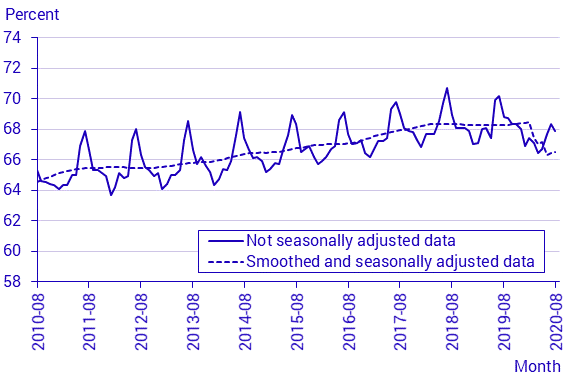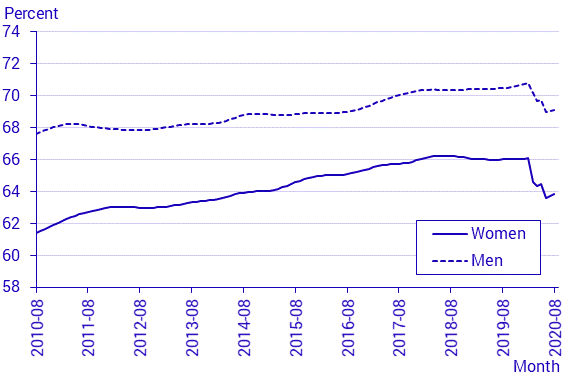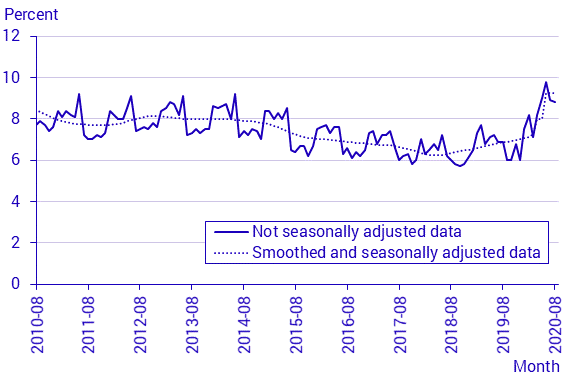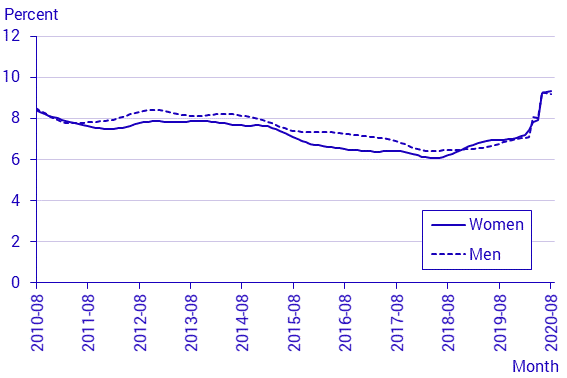Labour Force Surveys (LFS), August 2020
Labour market stabilised
Statistical news from Statistics Sweden 2020-09-15 9.30
In August 2020, there were 5 116 000 employed persons. The number of unemployed persons increased by 114 000 to 494 000. This corresponds to an unemployment rate of 8.8 percent, up by 1.9 percentage points. Among young people, the unemployment rate increased by 6.3 percentage points to 22.5 percent. Average hours worked amounted to 119.8 million hours per week, a decrease of 3.1 percent, calendar adjusted. According to seasonally adjusted and smoothed data, employment decreased, while unemployment increased compared with February 2020. However, employment and unemployment have stabilised, as no further detrimental changes have been noted since June. The unemployment rate was 9.3 percent.
The labour force
In August 2020, there were 5 610 000 persons aged 15–74 in the labour force, not seasonally adjusted. There were 2 928 000 men and 2 682 000 women in the labour force. The relative labour force participation rate was 74.4 percent. Among women, this rate was 72.5 percent and among men the rate was 76.3 percent. Among young people aged 15–24 years, there were 628 000 persons in the labour force, a decrease of 47 000 compared with the same month a year ago. The relative participation rate among young people decreased by 4.0 percentage points and amounted to 54.5 percent.
According to seasonally adjusted and smoothed data, there were 5 526 000 persons in the labour force and the labour force participation rate was 73.3 percent. It is worth noting that both the number and the proportion of persons in the labour force has stabilised since the lowest rate in 2020 was noted in March.
Employment
In August 2020, there were 5 116 000 employed persons aged 15─74, not seasonally adjusted. There were 2 422 000 employed women and 2 695 000 employed men. The employment rate was 67.9 percent. Among women, this rate was 65.4 percent and among men it was 70.3 percent. There were 486 000 young employed people aged 15–24 years, which is a decrease of 79 000 persons, and the employment rate amounted to 42.2 percent, which corresponds to a decrease of 6.8 percentage points.
According to seasonally adjusted and smoothed data, there were 5 015 000 employed persons. This is a decrease of 141 000, of whom 76 000 were young people, compared with February 2020, when the effects of COVID-19 were not yet discernible on the Swedish labour market. The employment rate was 66.5 percent, a decrease of 1.9 percentage points compared with February 2020. On the other hand, the number and proportion of persons employed has not decreased further, as June, July and August noted similar levels.
Employees
In August 2020, there were 4 617 000 employees, not seasonally adjusted. This is a decrease of 88 000 persons compared with the same month a year ago. There were 3 849 000 permanent employees and 768 000 temporary employees. The number of temporary employees decreased by 106 000 compared with the same month a year ago. Among young people aged 15–24 years, the number of temporary employees decreased by 52 000 and amounted to 289 000.
Compared with February 2020, seasonally adjusted and smoothed data show a decrease of 142 000 in the number of employees, of whom 42 000 were permanent employees and 101 000 were temporary employees. As with the employment figures, there have been no significant changes with regard to the number of employees since June.
Hours worked
For the period February to July, the number of hours worked has been corrected. Further information is available here:
The average number of hours worked in August 2020 amounted to 119.8 million per week, not seasonally adjusted. In calendar-adjusted figures, this corresponds to a decrease of 3.1 percent compared with the corresponding month a year ago. In hotels and restaurants, the number of hours worked, calendar-adjusted, decreased by 21.8 percent compared with August 2019.
Seasonally adjusted and smoothed data shows that the average number of hours worked per week amounted to 146.1 million, which is 9.7 million hours per week less than in February 2020. However, this decline has slowed in recent months, and the lowest rate in 2020 was noted in April.
In work and absence
There were 3 401 000 persons employed and in work in August 2020, not seasonally adjusted. The LFS estimates the number of persons who were absent for the whole week or for part of the week from their principal occupation by main reason for absence. There were 1 743 000 persons absent for the whole week in August 2020, not seasonally adjusted. Among these, 84 000 were absent due to illness and 23 000 were absent for the whole week due to lack of work. There were 1 392 000 persons absent due to holidays.
Among persons who were absent due to lack of work or lay-offs, absence during only part of the week was common. There were 104 000 persons in total absent for the whole week or part of the week due to lay-offs. The information about the number of lay-offs during August should be interpreted with some caution, as persons who were laid off and who were on holiday in August may have listed holidays as their main reason for absence. There were 67 000 persons who stated lack of work as their main reason for absence.
Seasonally adjusted and smoothed data showed that there were 4 212 000 persons in work, which is 155 000 fewer than in February 2020. There were 802 000 persons absent for the entire week. The lowest number of employed persons in work in 2020, noted in April, has since increased by 113 000 persons.
Unemployment
In August 2020, there were 494 000 unemployed persons aged 15–74 years, not seasonally adjusted, which is 114 000 more than in the corresponding month a year ago. The unemployment rate was 8.8 percent, which is an increase of 1.9 percentage points. The number of unemployed men increased by 48 000 and amounted to 233 000, while the number of unemployed women increased by 66 000 and amounted to 260 000. Among men, the unemployment rate increased by 1.6 percentage points to 8.0 percent and among women the unemployment rate increased by 2.3 percentage points to 9.7 percent. There were 141 000 unemployed young people aged 15–24 years. This corresponds to a youth unemployment rate of 22.5 percent, up by 6.3 percentage points.
Among persons aged 15–74 years, seasonally adjusted and smoothed data shows an increase of 116 000 unemployed persons, as well as an increase of 2.1 percentage points in the proportion of unemployed persons compared with February 2020. In August 2020, there were 511 000 unemployed persons, which corresponds to an unemployment rate of 9.3 percent. Among young people aged 15–24, seasonally adjusted and smoothed data shows an increase in both the number and proportion of unemployed persons compared to February 2020. The number of unemployed young people increased by 44 000 and amounted to 169 000, and the unemployment rate increased by 8.5 percentage points to 28.4 percent.
As with the employment figures, seasonally adjusted and smoothed data shows that the unemployment rate has remained unchanged since June 2020.
Impact of COVID-19 on the labour market
In view of the ongoing coronavirus (COVID-19) pandemic, additional questions concerning the impact of COVID-19 have been added to the LFS. Based on these questions, 90 000 employed persons aged 15–74 years stated that they were absent during the whole reference week in August related to COVID-19. This means that among persons who were absent during the entire reference week, 5.2 percent were absent due to COVID-19. The proportion was 5.9 percent for men and 4.6 percent for women.
Among employees aged 15–74 years who were absent during the entire reference week, 4.5 percent, which corresponds to 71 000 persons, stated that their absence was linked to COVID-19. The proportion was 4.8 percent for men and 4.2 percent for women. Furthermore, 25.3 percent of employees, which corresponds to 132 000 persons, who were absent during part of the reference week stated that their absence was linked to COVID-19. Among self-employed persons and assisting household members aged 15–74 years, 40.8 percent felt that they had less work due to the coronavirus pandemic, while 15.6 percent felt that they had more work.
To be classified as unemployed in the LFS, a person must be without a job, must be able to start work and must have sought work. This means that people who are without a job, but who have not been seeking work or are not available to start work are not classified as being unemployed, but are classified, instead, as not being in the labour force. In August 2020, 1 927 000 persons aged 15–74 years were outside the labour force. Among these people, 69 000 stated that they would have been available to work, but had not looked for work due to COVID-19. In addition, 23 000 persons stated that they would not have been able to start their job due to COVID-19.




Next publishing will be
2020-10-15 at 9:30.
Feel free to use the facts from this statistical news but remember to state Source: Statistics Sweden.
